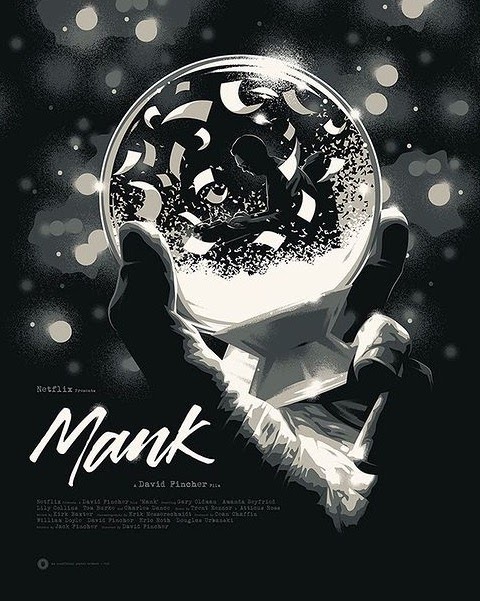2021’s Oscar Magnet
Review on “Mank”
To film, or not to film? That is the question brought to Herman J. Mankiewicz as he writes the screenplay for what is deemed the greatest film of all time, “Citizen Kane”, in the ten-time Oscar-nominated drama “Mank”.
Set in Victorville, California in the year 1940, the extraordinary aspects of the film include the costume and production design, the acting and directing, the music score, the character building of Mank, the allusions to “Citizen Kane”, and the fine attention to detail.
All the costumes worn throughout the film seemed elegant and fitting for the Hollywood elites, with special attention being set to the most affluent wearing the most expensive wardrobe. The specificity of this makes the audience feel as if they’re amongst the upper class.

The production design is also top-notch, with the many homes, studios, and halls making the audience truly encapsulated in the magic of Tinseltown. For this reason and many more, “Mank” was nominated for Oscars in both these categories.
“Mank” was also nominated for Best Actor and Best Supporting Actress thanks to the talents of Gary Oldman as the titular character and Amanda Seyfried as Marion Davies. Both pulled through with performances that could make audiences believe they were the real people!
David Fincher truly deserves his Oscar nomination for Best Director as he takes us through The Golden Age of Hollywood with the numerous shots and angles he uses at his will.
With all sorts of music from jazz to more orchestral pieces being used, Trent Reznor and Atticus Ross truly encapsulated the time period to get their nomination for Best Original Score.
To get into further detail, the character of Mank is built as very three-dimensional.
On the one hand, he’s a witty alcoholic gambler who always finds ways to make his situation even worse than before, like when he betted $24,000 on an election result.
On the other hand, he’s a kind soul who loves human connection, such as his talks with Marion and him buying freedom for 100+ people to come to America from Nazi-occupied Germany.
This creates a character that the audience can both root for and despise all at once, a marvelous showcase of how people live their lives as grey, not simply black and white.
For people who’ve seen “Citizen Kane”, there are many scenes strewn throughout “Mank” that allude to the 1941 masterpiece.
Early on, Mank gets hold of some alcohol and passes out with the bottle rolling out of his hand and hitting the floor. This is an allusion to the iconic “Rosebud” scene, where Kane has his snowglobe roll out of his hand and hit the floor.
Next comes the scene where Louis B. Mayer is giving a speech to his employees about pay cuts due to the looming threat of the Great Depression.
The scene is shot from directly behind Mayer, with shadows thrown throughout the frame and the spotlights hitting him very harshly.
This scene’s direction mirrors the “Citizen Kane” scene where the editor-in-chief asks his crew to find out the meaning of “Rosebud”, shadows, spotlights, and all.
Later in the film, Mank and Metcalf are watching a filmed fake newsreel. This “raw newsreel feel” is shown in “Citizen Kane” as the second scene that recaps Kane’s life.
Something noteworthy about the film is its heavy use of flashbacks. This technique is used heavily in “Citizen Kane” in order to piece together Charles’ life, the same way it pieces together Mank’s life.
Lastly, near the end of the film, Orson Welles throws a box of liquor into a cabinet as he gets fed up with Mank, destroying the box in the process.
This inspires Mank to write a scene of “an act of purging violence” into the script of “Citizen Kane”, which is ultimately used when Susan leaves Kane.
The fine details spread throughout the film are what truly make it feel even more magical.
The movie opens up with background knowledge of “Citizen Kane’s” development in order to give the audience better knowledge heading into the film.
The movie being shot in black and white makes for a film that truly feels like it came out of the Golden Age of Hollywood!
Having opening credits for the main actors adds to the feel of a classic movie since that’s how it was originally done.
All the flashback scenes throughout the movie start with typewriter text on how it would appear on a screenplay, adding to the whole “Mank writing a screenplay” vibe.
The parable of the organ grinder’s monkey is brought up twice in the film, first with no context, and then later the audience learns the context through a flashback. The way it’s presented truly rewards audience members for paying attention to key scenes!
Near the end of the film, a radio interview of the real Orson Welles is used to show how he had serious conflict with Mank, adding to the film’s climax.
Lastly, the film ends with Mank giving a speech denouncing Orson Welles, followed by a screen of text displaying his life after the film.
Even though the film piggybacks off the success of “Citizen Kane”, “Mank” is a masterpiece in its own right with its magnificent costume and production design, acting and directing, music score, character development, allusions, and fine details.
As mentioned earlier, “Mank” has been nominated for ten Oscars. In comparison, “Citizen Kane” was nominated for nine and only won one. Tune in to the Oscars on April 25th to see if “Mank” fairs any better!
Your donation will support the student journalists of North Hollywood High School. Your contribution will allow us to purchase equipment and cover our annual website hosting costs.

